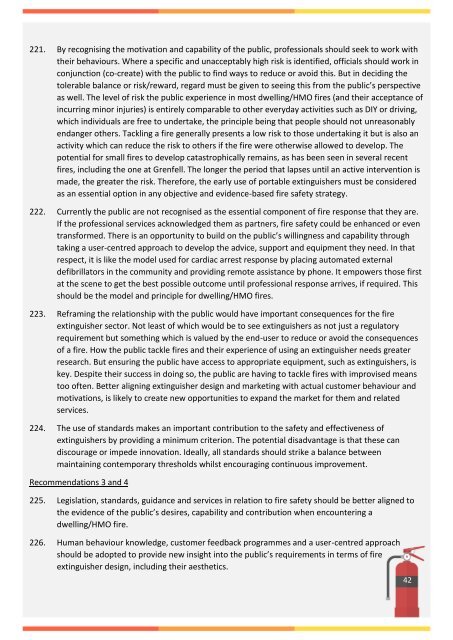An evaluation of the role of fire extinguishers
A report considering the role of a fire extinguisher in human terms identifying the gap between policy assumptions and the evidence from real fires. It considers the implications arising from this and makes a number of recommendations to create an evidence base and enhance current fire safety policies/advice.
A report considering the role of a fire extinguisher in human terms identifying the gap between policy assumptions and the evidence from real fires. It considers the implications arising from this and makes a number of recommendations to create an evidence base and enhance current fire safety policies/advice.
Create successful ePaper yourself
Turn your PDF publications into a flip-book with our unique Google optimized e-Paper software.
221. By recognising <strong>the</strong> motivation and capability <strong>of</strong> <strong>the</strong> public, pr<strong>of</strong>essionals should seek to work with<br />
<strong>the</strong>ir behaviours. Where a specific and unacceptably high risk is identified, <strong>of</strong>ficials should work in<br />
conjunction (co-create) with <strong>the</strong> public to find ways to reduce or avoid this. But in deciding <strong>the</strong><br />
tolerable balance or risk/reward, regard must be given to seeing this from <strong>the</strong> public’s perspective<br />
as well. The level <strong>of</strong> risk <strong>the</strong> public experience in most dwelling/HMO <strong>fire</strong>s (and <strong>the</strong>ir acceptance <strong>of</strong><br />
incurring minor injuries) is entirely comparable to o<strong>the</strong>r everyday activities such as DIY or driving,<br />
which individuals are free to undertake, <strong>the</strong> principle being that people should not unreasonably<br />
endanger o<strong>the</strong>rs. Tackling a <strong>fire</strong> generally presents a low risk to those undertaking it but is also an<br />
activity which can reduce <strong>the</strong> risk to o<strong>the</strong>rs if <strong>the</strong> <strong>fire</strong> were o<strong>the</strong>rwise allowed to develop. The<br />
potential for small <strong>fire</strong>s to develop catastrophically remains, as has been seen in several recent<br />
<strong>fire</strong>s, including <strong>the</strong> one at Grenfell. The longer <strong>the</strong> period that lapses until an active intervention is<br />
made, <strong>the</strong> greater <strong>the</strong> risk. Therefore, <strong>the</strong> early use <strong>of</strong> portable <strong>extinguishers</strong> must be considered<br />
as an essential option in any objective and evidence-based <strong>fire</strong> safety strategy.<br />
222. Currently <strong>the</strong> public are not recognised as <strong>the</strong> essential component <strong>of</strong> <strong>fire</strong> response that <strong>the</strong>y are.<br />
If <strong>the</strong> pr<strong>of</strong>essional services acknowledged <strong>the</strong>m as partners, <strong>fire</strong> safety could be enhanced or even<br />
transformed. There is an opportunity to build on <strong>the</strong> public’s willingness and capability through<br />
taking a user-centred approach to develop <strong>the</strong> advice, support and equipment <strong>the</strong>y need. In that<br />
respect, it is like <strong>the</strong> model used for cardiac arrest response by placing automated external<br />
defibrillators in <strong>the</strong> community and providing remote assistance by phone. It empowers those first<br />
at <strong>the</strong> scene to get <strong>the</strong> best possible outcome until pr<strong>of</strong>essional response arrives, if required. This<br />
should be <strong>the</strong> model and principle for dwelling/HMO <strong>fire</strong>s.<br />
223. Reframing <strong>the</strong> relationship with <strong>the</strong> public would have important consequences for <strong>the</strong> <strong>fire</strong><br />
extinguisher sector. Not least <strong>of</strong> which would be to see <strong>extinguishers</strong> as not just a regulatory<br />
requirement but something which is valued by <strong>the</strong> end-user to reduce or avoid <strong>the</strong> consequences<br />
<strong>of</strong> a <strong>fire</strong>. How <strong>the</strong> public tackle <strong>fire</strong>s and <strong>the</strong>ir experience <strong>of</strong> using an extinguisher needs greater<br />
research. But ensuring <strong>the</strong> public have access to appropriate equipment, such as <strong>extinguishers</strong>, is<br />
key. Despite <strong>the</strong>ir success in doing so, <strong>the</strong> public are having to tackle <strong>fire</strong>s with improvised means<br />
too <strong>of</strong>ten. Better aligning extinguisher design and marketing with actual customer behaviour and<br />
motivations, is likely to create new opportunities to expand <strong>the</strong> market for <strong>the</strong>m and related<br />
services.<br />
224. The use <strong>of</strong> standards makes an important contribution to <strong>the</strong> safety and effectiveness <strong>of</strong><br />
<strong>extinguishers</strong> by providing a minimum criterion. The potential disadvantage is that <strong>the</strong>se can<br />
discourage or impede innovation. Ideally, all standards should strike a balance between<br />
maintaining contemporary thresholds whilst encouraging continuous improvement.<br />
Recommendations 3 and 4<br />
225. Legislation, standards, guidance and services in relation to <strong>fire</strong> safety should be better aligned to<br />
<strong>the</strong> evidence <strong>of</strong> <strong>the</strong> public’s desires, capability and contribution when encountering a<br />
dwelling/HMO <strong>fire</strong>.<br />
226. Human behaviour knowledge, customer feedback programmes and a user-centred approach<br />
should be adopted to provide new insight into <strong>the</strong> public’s requirements in terms <strong>of</strong> <strong>fire</strong><br />
extinguisher design, including <strong>the</strong>ir aes<strong>the</strong>tics.<br />
42<br />
0




